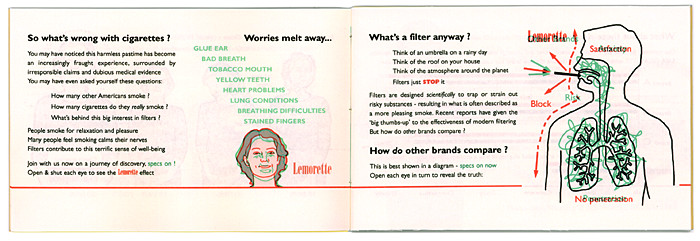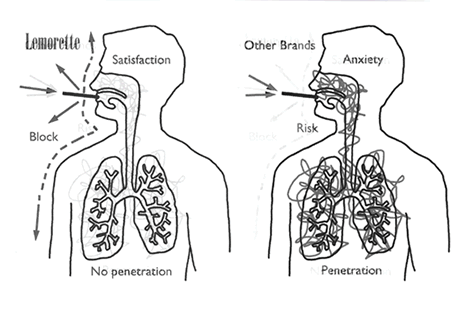
About the use of 3D
I experimented with 3D imagery to give a 'gimmicky' feel to the book. The book was therefore created in red/green anaglyph 3D for a sense of cheap novelty. 3D glasses are included in the front of the book and the consumer is instructed when to put them on and take them off. Some diagrams require the viewer to close one eye and then switch to the other in order to get the hidden messages within the pages - Viewing the book should feel complex and yet embarassing.
The section, What's 3D and why the funny-looking glasses? Seeks to explain how to view 3D, suggesting that the novely glasses can enhance understanding, whereas the over complex information instead seeks to cloud the issue and bedazzle the consumer.
There are two types of anaglyph illustrations used in the book;1. A composite image that appears to have several levels when viewed with the red/green glasses.
e.g. the image of the Lemorette factory on p.20, A Doctor Speaks... the image of Dr.Wolf's endorsement on p.2,
and all six of the separate stuck-in cigarette cards.
2. Two separate images, one in green, the other in red viewed by opening and closing each eye in turn.
e.g. the image of the woman on p.6 Worries melt away... , the diagram on p.7 What's a filter anyway? and the face in the rounded box on the cover of the book.
What's a filter anyway? / How do other brands compare?
This diagram needs to be viewed by blinking each eye in turn to see the Lemorette brand stopping all harmful lines from penetrating the body, closing the other eye shows tangled lines in the lung area when a different brand is smoked.

The illustrations (below) show how the illustration is seen in the green lense only (left) and the red lense only (right).

Creating Anaglyphs
I used Adobe Photoshop to separate my illustrations into about 6 layers and then created a red and green version of each layer. To make images appear closer to the viewer the red layer should be shunted to the right. In order to make the image recede the red layer should be shunted to the left.
For more infomation on 3D technology, see the reference list in Volume 8